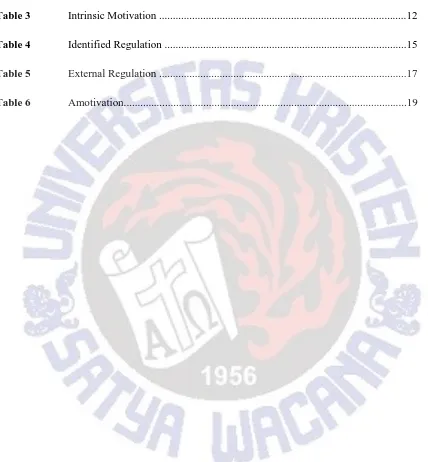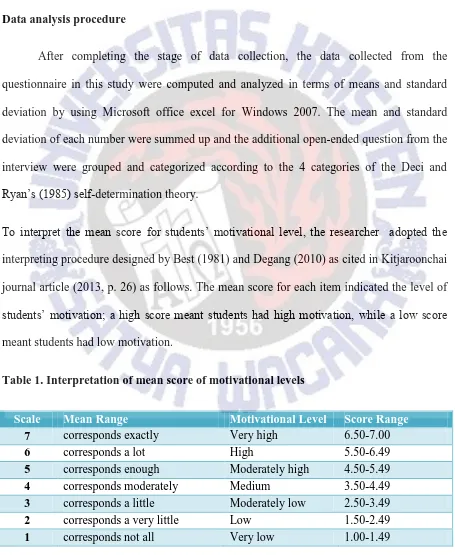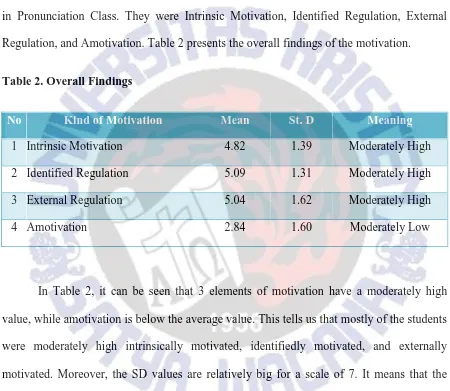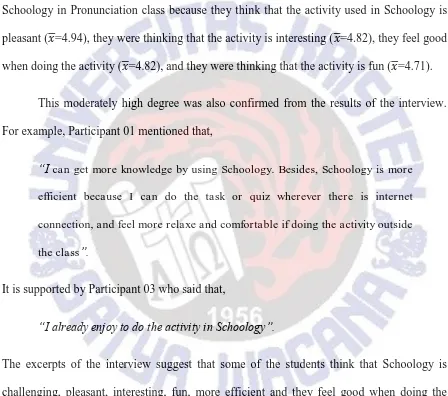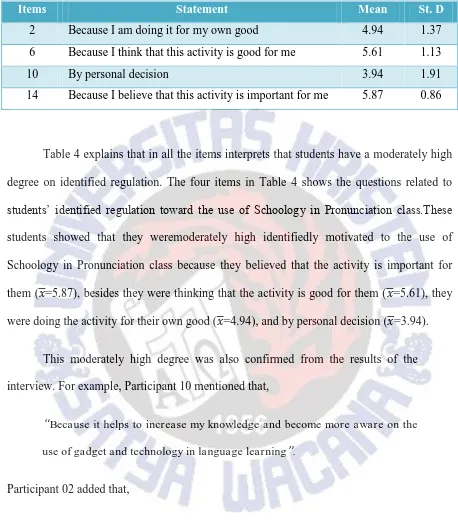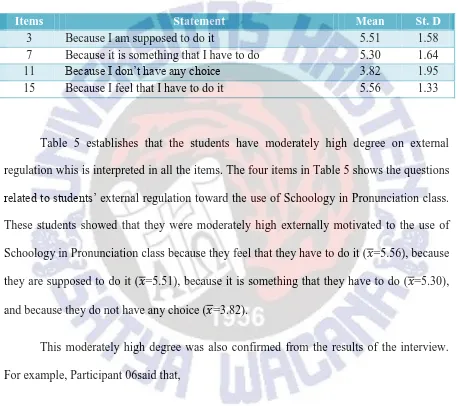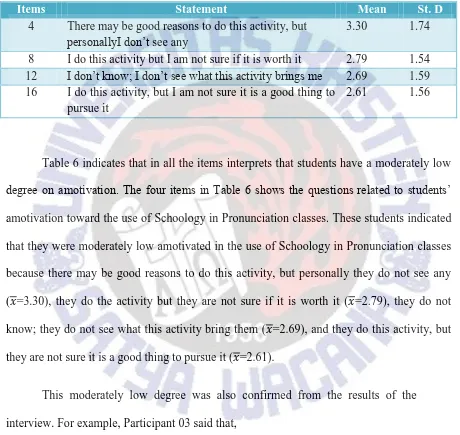ST
UDENTS’ MOTIVATION
IN USING SCHOOLOGY IN
PRONUNCIATION CLASS
THESIS
Submitted in Partial Fulfillment Of the Requirements for the Degree of
Sarjana Pendidikan
Hapsari Catur Hanandya 112012133
ENGLISH LANGUAGE EDUCATION PROGRAM
FACULTY OF LANGUAGE AND LITERATURE
SATYA WACANA CHRISTIAN UNIVERSITY
SALATIGA
v
COPYRIGHT STATEMENT
This thesis contains no such material as has been submitted for examination in any course or accepted for the fulfillment of any degree or diploma in any university. To the best of my knowledge and my belief, this contains no material previously published or written by any other person except where due reference is made in the text.
Copyright@ 2016. Hapsari Catur Hanandya and Dian Toar Y.G Sumakul, M.A
All rights reserved. No part of this thesis may be reproduced by any means without the permission of at least one of the copyright owners or the English Language Education Program, Faculty of Language and Literature, Satya Wacana Christian University, Salatiga.
LIST OF TABLE
Table 1 Interpretation of mean score of motivational levels ...10
Table 2 Overall Findings ...11
Table 3 Intrinsic Motivation ...12
Table 4 Identified Regulation ...15
Table 5 External Regulation ...17
STUDENTS’ MOTIVATION IN USING SCHOOLOGY IN PRONUNCIATION
CLASS
Hapsari Catur Hanandya
Abstract
Technology takes an important role in almost all aspects of human beings‟ lives, including in English language learning. Numerous studies have suggested the use of technology in language learning has positive effects on students‟ motivation and behavior in learning. The use of online media in language learning such as Schoology is proven more efficient to gain students‟ motivation. However, there are some factors that can reduce the students‟ motivation in using Schoology. This study attempted to find the students‟ motivation in using Schoology in Pronunciation classes. The study took place in English Language Education Program in Satya Wacana Christian University. There were thirty-nine participants who participated in this study. The data were collected by using motivational questionnaire measuring 4 major types of human motivation (intrinsic motivation, identified regulation, external regulation, and amotivation) which was adapted from “The Situational Motivation Scale (SIMS)” by Guay, vallerand, and Blanchard (2000). The data collected from the questionnaire were computed and analyzed in terms of means and standard deviation, and the results were grouped and categorized according to the 4 categories of Deci and Ryan‟s (1985) self-determination theory. The data analysis suggested that the students‟ motivation on the use of Schoology in Pronunciation class shows moderately high degree of motivational level in intrinsic motivation, identified regulation, and external regulation, while the result indicates moderately low degree of amotivation.
Key Words: Motivation, Self-determination theory, LMS, Schoology, technology in
INTRODUCTION
Motivation involves a set of interests, perceptions, and attitude which is related to each other and takes an important role in language learning. Learner‟s success in language
learning is affected by motivation as it acts the crucial factor in successful language learning. This is in line with Tuan (2012, as cited in Jafari, 2013) who mentioned that motivation was one of the factors influencing the success of the second language learners. In short, the learners‟ success in language learning is closely related to their motivation. It
includes students‟ desire, purpose to learn language, or their attitude toward language learning process. As Sanacore (2008, as cited in Granito & Chernobilsky, 2012, p.2) has pointed out, motivation was the key to academic success as well as promoting lifelong learning.
3
blended or online learning is the Schoology (Sicat, 2015). Wall (2014, as cited in Sicat, 2015, p. 4) added that Schoology provided more configurable features than Facebook, such as submitting assignments, taking tests, making comments, asking questions, and retain access to resources in courses after semester ends. It shows that Schoology provides more advantages in language learning process.
Furthermore, investigating the students‟ motivation by using Schoology in
Pronunciation classes will be more interesting because it provides more than pronunciation learning, but also create the students‟ motivation in Pronunciation learning through Schoology. Particularly for the students who learn English as a second or foreign language, they will find difficulties in pronunciation. The purpose of the research was to look for the students‟s motivation in using Schoology in their Pronunciation class.
From this study, it is expected that the result of the research will provide some new perspectives on the relation between students‟ motivation by using Schoology to gain their interest and motivation in Pronunciation learning classes.
LITERATURE REVIEW Defining Motivation
Motivation could be as a parameter in students‟ successful learning process that involves a set of interests, perceptions, and attitude which is relate to each other and takes an important role in language learning. Learner‟s success in language learning is affected by
related to their motivation. Therefore it is difficult for students to learn a second language if they do not have self-motivation in language learning. Motivation is a complex concept and might be seen as a simple word which has been defined in multiple ways. The different meaning and view may come from different people. For this reason, it is difficult to provide one concrete definition about the idea of motivation. An example is given by Dornyei (1998) who stated that:
Although „motivation‟ is a term frequently used in both educational and research
contexts, it is rather surprising how little agreement there is in the literature with regard to the exact meaning of this concept (p. 117).
In terms of motivation, there are several simpler definitions according to some experts. The first definition is offered by Chang (2005, p. 2) who argues that motivation can be seen as a force that makes a person to do an action and to keep on until the goals are achieved. It means that motivation plays an important role in students‟ successful learning
process. This is line with Pintrich & Schunk (2002) that explained that a general definition related to prior research is that motivation is “process by which goal-directed activity is instigated and sustained” (p. 4).
Types of motivation
5
motivation, extrinsic motivation, and amotivation to account for the differing reasons why individuals engage in activities.
Intrinsic motivation. Intrinsic motivation is related to the individual‟s motivational
stimuli are coming from inside because of the willingness, eagerness, and purpose to learn the language. According to Harmer (2007), intrinsic motivation comes from within the individual. It means that students‟ desire, purpose to learn language, or their attitude toward language learning process motivated them to learn language. Furthermore, according to Yue yu (2012), people are intrinsically motivated because of an interest, curiosity, and doing the activity itself is a reward. In relation to that, students learning English because of their interest without any compulsion. It is supported by Deci (1971), Lepper et al. (1973), Gagné & Deci (2005) (as cited in Reinholt, 2006, p. 2) intrinsically motivated behavior is perceived as behavior freely engaged in, which the individual finds interesting and derives spontaneous satisfaction and enjoyment from.
Extrinsic motivation. In contrast, extrinsic motivation is related to the individual‟s
motivational stimuli are coming from outside because of the necessity or imperative to learn the language. It could be from family, friends, or even the society. According to Harmer (2007), extrinsic motivation is caused by any number of outside factors, for example, the need to pass an exam, the hope for financial reward, or the possibility of future travel. It means the students motivated to learn English is because the necessity or demand. Yue Yu (2012) points out that people are extrinsically motivated because of reward or positive feedback from others. External motivation focuses on the external factors and learning activities in language learning.
Amotivation. In Self-determination theory, amotivation refers to individual
that, amotivated behaviors are relatively to the least self-determined because there is no sense of purpose and no expectations of reward or possibility of changing the course of events.
Learning Management System (LMS)
Rouse (2005) defines LMS as online communication language learning via networked computers. According to Rouse (2005, as cited in Sicat, 2015) “learning management system (LMS) is a software application or Web-based technology used to plan, implement, and assess a specific learning process” (p. 3). Moreover, Sicat (2015) explained that LMS has become a powerful tool even for consulting companies that specialize in staffing and training, extension schools, and any corporation looking to get a better grasp on the continuing education of its workforce. LMS provides more than just a tool and it is considered to use in learning process.
Based on some experts' perspectives, many studies provide that LMS could bring positive effects and advantages to the students in learning English. Sharma & Vatta (2013) explain the advantages of LMS. For example, LMS can increase motivation of learners, promote learning, encourage interaction, provide feedback and support can be provided during the learning process, supports content in various formats, e.g. multimedia, video, and text. Besides, the course material is updated and students can see the changes made in the particular field. Teachers can modify information according to the need of the student. Moreover, various activities are offered to the learners to make choices out of it.
Motivation in LMS
7
students‟ self motivation to learn language. Correspondingly, Al-Ammary (2003) in his study to investigate the effect of using Educational Technology on the achievement and performance of students at the University of Bahrain stated that “the learning achievement
of students is affected when the teaching and learning processes are enhanced by Educational Technology” (p. 62). Hence, it motivates the students to become more involved, active and interested in learning. By seeing students‟ motivation raises toward the use of technology in learning, teacher can cover the students with various activities using technology to gain learners‟ motivation in language learning. The implementation of
technology in language learning by using Learning Management System (LMS) is considered to use in learning process.
THE STUDY
Research Question
“What kind of motivation do the students employ when using Schoology in Pronunciation
class?”
Context
The research was a descriptive study on students‟ motivation in using Schoology in Pronunciation class at Faculty of Language and Literature of Satya Wacana Christian University. Descriptive method was chosen because it has derived acceptance as a valid form of research in education. Borg and Gall (1989) stated that descriptive research describes natural or man-made educational phenomena that is of interest to policy makers and educators. It observed the students‟ motivation by using Schoology, a Learning Management System (LMS) in Pronunciation class.
Participants
9 Instruments of data collection
The method that used in investigation is very important to get a valid data. This study used a questionnaire and interview as a tool of collecting data. The data were collected by using motivational questionnaire which was adapted from “The Situational Motivation Scale (SIMS)” by Guay, Vallerand, and Blanchard (2000) (see Appendix A). There were 16 items in the questionnaire and classified into four categories. Each of the categories was represented by four questions as explained above. The correspondents were asked to respond the statement using Likert Scale of 7 points. The 7-point options were corresponds not all (1); corresponds a very little (2); corresponds a little (3); corresponds moderately
(4); corresponds enough (5); corresponds a lot (6); corresponds exactly (7).
The other method that was used in this research was interview. The interview for each participant was around 10-20 minutes. Advantages of interviews were listed by Saunders et al (2007) as the possibility of obtaining comprehensively detailed primary data than can be immediately analyzed. It meant that the researcher have the possibility to get deeper data in face to face interview. Furthermore, by conducting the interview, the researchers will get richer data, opinions, patterns, and various thoughts toward the topic (Trost, p.7 as cited in Carlsson, 2008). The aim of interview in this research, which was unstructured interview, is helpful to explore and to know the reason or motivation why the interviewee choose the statement using 7-point Likert scale of the questionnaire above. However, sometimes unplanned questions also useful to clarify any other related points and follow up the answers.
Data collection procedure
then it was shared to four Pronunciation classes via Schoology. There were 39 students who deviation of each number were summed up and the additional open-ended question from the interview were grouped and categorized according to the 4 categories of the Deci and Ryan‟s (1985) self-determination theory.
To interpret the mean score for students‟ motivational level, the researcher adopted the
interpreting procedure designed by Best (1981) and Degang (2010) as cited in Kitjaroonchai journal article (2013, p. 26) as follows. The mean score for each item indicated the level of students‟ motivation; a high score meant students had high motivation, while a low score
meant students had low motivation.
Table 1. Interpretation of mean score of motivational levels
Scale Mean Range Motivational Level Score Range
7 corresponds exactly Very high 6.50-7.00
6 corresponds a lot High 5.50-6.49
5 corresponds enough Moderately high 4.50-5.49
4 corresponds moderately Medium 3.50-4.49
3 corresponds a little Moderately low 2.50-3.49
2 corresponds a very little Low 1.50-2.49
11
FINDINGS AND DISCUSSION
The following section presents findings and discussions of the study which provides the answer to the research question. The discussion shows descriptive findings based on Self-Determination Theory (SDT) by Deci and Ryan (1985). This study found that there were 4 major types of human motivation affecting students‟ motivation in using Schoology in Pronunciation Class. They were Intrinsic Motivation, Identified Regulation, External Regulation, and Amotivation. Table 2 presents the overall findings of the motivation.
Table 2. Overall Findings
No Kind of Motivation Mean St. D Meaning
1 Intrinsic Motivation 4.82 1.39 Moderately High 2 Identified Regulation 5.09 1.31 Moderately High 3 External Regulation 5.04 1.62 Moderately High 4 Amotivation 2.84 1.60 Moderately Low
From the 4 elements of motivation, it can be seen that amotivation had moderately low mean score of 2.84 for the questionnaire results. It depicts that mostly of the students were not amotivated, instead they inclined to be intrinsically, identifiedly and externally motivated. It could be interpreted that most of the students had already accepted the behavior to follow the activities in Schoology as personally important and take it as his/her own value. Afterwards, it followed by the students‟ behavior which is regulated by rewards or in order to avoid negative consequences. It means that the process of somewhat internalization and externalization was successfully done that the activities in Schoology for Pronunciation classes became more autonomous for most of all students.
The following sections present the findings for each category of from the SIMS, namely Instrinsic Motivation, Identified Regulation, External Regulation, and Amotivation.
Intrinsic Motivation
Intrinsic motivation is motivation that is derived from the inside. It is come from personal interest, enjoyment, or pleasure. As Deci et al. (1999) observe, “intrinsic motivation energizes and sustains activities through the spontaneous satisfactions inherent in effective volitional action”. In this study, it was found that in general the students have a quite high degree on this matter. Table 3 summarizes the findings.
Table 3. Intrinsic Motivation
Item Statement Mean St. D
13
Table 3 shows that in all the items interprets that students have a moderately high degree on instrinsic motivation. The four items in Table 3 as shown are questions related to students‟ intrinsic motivation toward the use of Schoology in Pronunciation class. These
students indicated that they were moderately high intrinsically motivated to the use of Schoology in Pronunciation class because they think that the activity used in Schoology is pleasant ( =4.94), they were thinking that the activity is interesting ( =4.82), they feel good when doing the activity ( =4.82), and they were thinking that the activity is fun ( =4.71).
This moderately high degree was also confirmed from the results of the interview. For example, Participant 01 mentioned that,
“I can get more knowledge by using Schoology. Besides, Schoology is more
efficient because I can do the task or quiz wherever there is internet
connection, and feel more relaxe and comfortable if doing the activity outside
the class”.
It is supported by Participant 03 who said that,
“I already enjoy to do the activity in Schoology”.
However, from the quite a big value of the SD 1.39, it shows that the answers are quite diversed. In other words, some participants might not find the activities on Schoology as fun, interesting, pleasant, and feel good when doing the activity. The results of the interview also suggest this possibility. For example, Participant 04 said that,
“Because there is no variation in Schoology. They only submit assignments and do the quizzes”.
Participant 08 added that,
“Because as a beginner, they need clear explanation about Schoology and the activity become not interesting when the connection is not good enough”.
Based on the result of the interview above, it can be concluded that some of the participants might not intrinsically motivated. From the interview data, the factors that could affect this are bad internet connection, no variation in Schoology activities, and not clear explanation toward the use of Schoology from the lecturer.
Identified Regulation
15 Table 4. Identified Regulation
Items Statement Mean St. D
2 Because I am doing it for my own good 4.94 1.37 6 Because I think that this activity is good for me 5.61 1.13 10 By personal decision 3.94 1.91 14 Because I believe that this activity is important for me 5.87 0.86
Table 4 explains that in all the items interprets that students have a moderately high degree on identified regulation. The four items in Table 4 shows the questions related to students‟ identified regulation toward the use of Schoology in Pronunciation class.These
students showed that they weremoderately high identifiedly motivated to the use of Schoology in Pronunciation class because they believed that the activity is important for them ( =5.87), besides they were thinking that the activity is good for them ( =5.61), they were doing the activity for their own good ( =4.94), and by personal decision ( =3.94).
This moderately high degree was also confirmed from the results of the interview. For example, Participant 10 mentioned that,
“Because it helps to increase my knowledge and become more aware on the
use of gadget and technology in language learning”.
Participant 02 added that,
“Because my own decision, besides it is more efficient in place and time”.
al. (2000) stated that, “A boy who memorizes spelling lists because he sees it as relevant to writing, which he values as a life goal, has identified with the value of this learning activity”.
Nevertheless, from the quite a big value of the SD 1.31, it shows that the participants‟ answers are quite diversed. In other words, some participants might not find the activities on Schoology as an important activity, good for them, etc. The results of the interview also suggest this possibility. For example, Participant 04 said that,
“Because I am lazy to check Schoology therefore sometimes I missed the
information shared in Schoology”.
It is confirmed by Participant 07 who said that,
“Because it is an obligation. If we ignore the obligation, we cannot get a
grade”.
Based on the result of the interview, it can be inferred that some of the participants might not identifiedly motivated. The reason underlie the finding indicates on moderately high degree of motivation probably because of some reasons such as, the participants rarely check Schoology regularly and they think that using Schoology because it is an obligation for them to pass the course and get grades.
External Regulation
17
“External regulationis the least self-determined type of extrinsic motivation, referring to actions controlled by contingencies external to the individual (i.e., rewards, threat of punishment)”. In this study, it was found that mostly of the students have a moderately high
degree on this matter. The table below summarizes the findings.
Table 5. External Regulation
Items Statement Mean St. D
3 Because I am supposed to do it 5.51 1.58 7 Because it is something that I have to do 5.30 1.64 11 Because I don‟t have any choice 3.82 1.95 15 Because I feel that I have to do it 5.56 1.33
Table 5 establishes that the students have moderately high degree on external regulation whis is interpreted in all the items. The four items in Table 5 shows the questions related to students‟ external regulation toward the use of Schoology in Pronunciation class. These students showed that they were moderately high externally motivated to the use of Schoology in Pronunciation class because they feel that they have to do it ( =5.56), because they are supposed to do it ( =5.51), because it is something that they have to do ( =5.30), and because they do not have any choice ( =3.82).
This moderately high degree was also confirmed from the results of the interview. For example, Participant 06said that,
“Because it (use Schoology) is an obligation if I want to pass the course”.
Participant 10 also supported that,
“Because it is an obligation from the lecturer, besides the quizzes and
assignments will be done through Schoology. Therefore if we did not follow
The above excerpts indicates that some of the participants use Schoology because of some reasons, such as they feel that they have to do it because it is an obligation for them to pass the course,and to get a grade. As supported by Deci et al. (2000) mentioned that, “such behaviors are performed to satisfy an external demand or obtain an externally imposed reward contingency”. It means that the students‟ behavior takes an important role in external
regulation to obtain rewards or to avoid punishment.
Nevertheless, from the quite a big value of the SD 1.62, it depicts that the participants‟ answers are quite diversed. In short, some participants might not find the activities on Schoology as something that they have to do, etc. The results of the interview also propose this possibility. For example, Participant 01 mentioned that,
“Because I do not have any choices but I am happy to do the activity used in
Schoology. It (Schoology) also important to increase my language skill”.
Participant 10 agreed that,
“If I did not do the assignments or the quizzes then I will not develop”.
Based on the result of the interview, it can be concluded that some of participants might not externally motivated. From the interview data, the factors that could affect this are Schoology can increase the language skill, and will not develop if they did not do the assignments.
Amotivation
19
autonomous regulation embraced by self-determination theory” (p. 5). This study was found that mostly of the students have moderately low degrees on this matter. The table below explains the findings.
Table 6. Amotivation
Items Statement Mean St. D
4 There may be good reasons to do this activity, but personallyI don‟t see any
Table 6 indicates that in all the items interprets that students have a moderately low degree on amotivation. The four items in Table 6 shows the questions related to students‟
amotivation toward the use of Schoology in Pronunciation classes. These students indicated that they were moderately low amotivated in the use of Schoology in Pronunciation classes because there may be good reasons to do this activity, but personally they do not see any ( =3.30), they do the activity but they are not sure if it is worth it ( =2.79), they do not know; they do not see what this activity bring them ( =2.69), and they do this activity, but they are not sure it is a good thing to pursue it ( =2.61).
This moderately low degree was also confirmed from the results of the interview. For example, Participant 03 said that,
“Schoology is more efficient, it helps us easier to do the assignments, to
communicate with the lecturer whether there is regular class or not”.
“Because there must be a good reason why the lecturer asks to use
Schoology. It is not merely to submit assignments or tasks, but we also know
about the technology and become more understanding to use it”.
The excerpts of the interview indicates that some of the participants use Schoology because of some reasons, such as Schoology is more efficient, and it teaches the students understand more about technology and how to use it.
However, from the quite a big value of the SD 1.60, it shows that the participants‟ answers are quite diversed. In other hand, some participants might not find the good reasons from the activities used in Schoology. The results of the interview also proposes this possibility. As supported by Deci et al. (1985, 1991, cited in Standage et al., 2003), “Amotivation stems from a lack competence, the belief that an activity is unimportant, and/or when an individual does not perceive contingencies between her/his behaviour and the desired outcome(s)” (p.5). As it supported by Participant 01,
“Because maybe for the efficiency of assignments submission, Schoology is
good enough but I did not see the use of Schoology can increase our
language skill”.
Participant 09 also supported that,
“Because I only see the use of Schoology as the tools if the lecturer did not
come to class, then we are asked to submit the tasks or assignment through
Schoology by comments or asks. There may be certain good reasons, but as
long as I take this course I only see the use of Schoology as I explained
21
The excerpts of the interview interprets the participants‟ moderately low degree amotivation in using Schoology in Pronunciation classes which means that mostly of the participants are motivated intrinsically or extrinsically to use Schoology such as, the participants did not see the usage of Schoology could increase their language skill and they did not see other good reasons from the use of Schoology except for submit assigmnet or tasks.
Pedagogical Implication
The pedagogical implication of this finding may become a useful suggestion for the scholars and instructors to improve the students‟ motivation on the use of Schoology in Pronunciation class in the future. How actually the usage of Schoology is perceived by the students may become instructors considerations optimize the learners‟ motivation in learning pronunciation. The instructor or any other concerned parties should consider technical issues before really using online platform for learning. According to Balash et al. (as cited in Al-Ammary, p. 10) asserted that, before taking a decision to adopt certain Educational Technology, the educational organizations need to develop strategic planning in which their vision and mission, together with the teaching and learning processes needs, should be identified and embedded in their strategy. Besides, it would be better for the instructors to provide a brief tutorial for the students before using the online learning media. In order to optimize the use of Schoology, the instructors may also need to make a policy for students in which having discussion in the online learning mediais compulsory. By doing this, it is expected that the students will be more familiar with the use of the platform and thus the pedagogical benefits offered will more likely to be achieved.
classroom but also in online media such as Schoology. By using this, the scholars will be more familiar with technology and online media used in learning. According to Al-Ammary (n.d., p. 9) mentioned that, the learning achievement of students is affected when the teaching and learning processes are enhanced by Educational Technology. It motivates the students to become more involved, active and interested in learning. In addition, the students must also feel comfortable in using Schoology in order to help them get the benefit from the activity used in Schoology. According to Sivin-Kachla (1998) found that students studying in a technology rich environment achieved higher marks in all subject areas, gained a positive attitude towards learning, were able to generate new ideas and built self confidence.
CONCLUSION
The purpose of this study was to analyze English Language Education Program (ELE Program) students‟ motivation of Satya Wacana Christian University on the use of Schoology in Pronunciation class. The study was conducted by interviewing ten participants chosen randomly from the total thirty-nine participants who filled out the motivational questionnaire adapted from “The Situational Motivation Scale (SIMS)” by Guay, vallerand,
and Blanchard (2000). At the end, this study concludes that the students‟ motivation on the use of Schoology in Pronunciation class shows moderately high degree of motivational level in intrinsic motivation, identified regulation, and external regulation, while the result indicates moderately low degree of motivational level in amotivation.
23
may hinder their learning process through Schoology. Besides, interaction through the platform is not preferred compared to face-to-face learning process. Finally, the use of Schoology potentially gains the students motivation in language learning. Nevertheless, technical problems in learning platform demand more students‟ awareness that may discomfort them.
The pedagogical implication of this finding may become a useful suggestion for the scholars, instructors and other related parties to improve the students‟ motivation on the use of Schoology in Pronunciation class in the future. There are some considerations for the instructor, such as optimize the learners‟ motivation in learning pronunciation, consider the learning platform for technical issues, provide a brief tutorial for the students before using the platform, and make a policy for students in which having discussion in the platform is compulsory. In addition, there are some considerations for the scholars in using Schoology in Pronunciation class, such as they should be more open-minded on the use of technology nowadays in language learning and must also feel comfortable in using Schoology in order to help them get the benefit from the activity used in Schoology.
Acknowledgement
25 References:
Al-Ammary, J. Educational Technology: A Way To Enhance Student Achievement At The University Of Bahrain. The Online Journal of New Horizons in Education, 3 (3), 54-65.
Borg, W. R. & Gall, M. D. (1989). Educational Research: an introduction. New York: Longman
Carlsson, Thomas. (2008). Homework for English from the students’ perspective. Retrieved
July 6, 2015 from
https://dspace.mah.se/bitstream/handle/2043/7664/dissertation%20thomas%20
carlsson.pdf?sequence=1
Chang, H. (2005). The relationship between extrinsic/intrinsic motivation and language learning strategies among college students of English in Taiwan. Taiwan: Ming Chuan University.
Choy, A. M. (2005). Defining Motivation: Perspectives from Early Childhood Educators.
Costa, C., Alvelosa, H., & Teixeira, L. (2012). The use of Moodle e-learning platform: a study in a Portuguese University. Procedia Technology , 334-343.
Deci, E. L., Koestner, R., & Ryan, R. M. (1999). A meta-analytic review of experiments examining the effects of extrinsic rewards on intrinsic motivation. Psychological Bulletin, 125(6), 627–668.
Deci, E. L., & Ryan, R. M. (1985). Intrinsic motivation and self-determination in human behavior. New York: Plenum.
Deci, E. L., & Ryan, R. M. (2000). Intrinsic and extrinsic motivations: classic definitions and new directions. Contemporary Educational Psychology 25, 54-67.
Deci, E. L., & Ryan, R. M. (2000). Self-Determination Theory and the Facilitation of Intrinsic Motivation, Social Development, and Well-Being. American Psychological Association, 55 (1), 6-78.
Granito, M., & Chernobilsky, E. (2012). The Effect of Technology on a Student' Motivation and Knowledge Retention. Northeastern Educational Research Association (NERA) Annual Conference, (pp. 1-22).
Guay, F., Vallerand, R. J., & Blanchard, C. (2000). On the Assessment of Situational Intrinsic and Extrinsic Motivation: The Situational Motivation Scale (SIMS).
Motivation and Emotion, 24 (03), 175-213.
Harmer, J. (2007). The Practice of English Language Teaching. 4th Edition. Pearson Education Limited.
Hull, C. L. (1943). Principles of behavior. New York: Appleton-Century-Crofts.
Jafari, S. S. (2013). Motivated Learners and Their Success in Learning a Second Language.
Theory and Practice in Language Studies, 3 (10), 1913-1918.
Kitjaroonchai, N. (2013). Motivation toward English language learning of students in secondary and high schools in education service area office 4, Saraburi Province, Thailand. International Journal of Language and Linguistics, 1 (1), 22-23.
O'Connor, B,P., &Vallerand, R, J., (1989). Religious Motivation in the Elderly: A French-Canadian Replication and an Extension. The Journal of Social Psychology, 130(1), 53-59.
Pintrich, P. R. (2003). A Motivational Science Perspective on the Role of Student Motivation in Learning and Teaching Contexts. Journal of Educational Psychology, 95 (4), 667– 686.
Pintrich, P. R., & Schunk, D. H. (2002). Motivation in Education: Theory, Research, and Applications (2nd ed). New Jersey Merrill Prentice Hall, 95 (4).
Reinholt, M. (2006, May). No More Polarization, Please! Towards a More Nuanced
Perspective on Motivation in Organizations. Center for Strategic Management and Globalization , 1-22.
Saunders, M, Lewis, P, Thornhill, A. (2007). Research Methods For Business Students
(4thed). Prentice Hall. Retrieved July 12, 2015 from
http://is.vsfs.cz/el/6410/leto2014/BA_BSeBM/um/Research_Methods_for_Busine
ss_Students__5th_Edition.pdf
Sharma, A., & Vatta, D. (2013, June). Role of Learning Management Systems in Education.
International Journal of Advanced Research in Computer Science and Software
27
Sicat, A. S. ( 2015). Enhancing College Students‟ Proficiency in Business Writing Via Schoology. International Journal of Education and Research , 3 (1), 159-178. Sivin-Kachala, J.(1998), Report in the effectiveness of technology in school,
1990-1997. Software Publisher's Association U.S. Congress, Office of Technology Assessment, Power On! New Tools for Teaching and Learning, OTA-SET-379 (Washington, D.C.: U.S. GPO, Sept. 1988).
Standage, M., Duda, J. L., & Ntoumanis, N. (2003, October 31). A Test of Self-Determination Theory in School Physical Education. British Journal of Educational Psychology: In Press , 1-40.
Appendix A: menggunakan skala dibawah ini, pilihlah nomor yang paling tepat menggambarkan alasan Anda menggunakan Schoology dalam kelas Pronunciation. Jawablah setiap item berdasarkan skala dibawah ini: 1: tidak tepat sama sekali; 2: sangat kurang tepat; 3: kurang tepat; 4: tidak terlalu tepat; 5: cukup tepat; 6: sangat tepat; 7: tepat sama sekali.
Mengapa Anda menggunakan Schoology dalam kelas Pronunciation?
1. Karena menurut pendapat saya, kegiatannya menarik 1 2 3 4 5 6 7 2. Karena saya melakukannyauntukkebaikansayasendiri 1 2 3 4 5 6 7 3. Karena keharusan bagi saya 1 2 3 4 5 6 7 4. Mungkin ada alasan mengapa kegiatan ini baik untuk dilakukan,
tetapi saya tidak melihatnya 1 2 3 4 5 6 7 5. Karena menurut saya kegiatan ini menyenangkan 1 2 3 4 5 6 7 6. Karena menurut saya kegiatan ini baik untuk saya 1 2 3 4 5 6 7 7. Karena itu adalah sesuatu yang harus saya lakukan 1 2 3 4 5 6 7 8. Saya melakukan kegiatan ini tapi saya tidak yakin apakah itu
bermanfaat bagi saya 1 2 3 4 5 6 7 9. Karena kegiatan ini sangat mengasyikkan 1 2 3 4 5 6 7 10. Karena keputusan saya pribadi 1 2 3 4 5 6 7 11. Karena saya tidak memiliki pilihan lain 1 2 3 4 5 6 7 12. Saya tidak tahu, saya tidak melihat apa yang saya dapat
dari kegiatan ini 1 2 3 4 5 6 7 13. Karena saya merasa senang ketika melakukan kegiatan ini 1 2 3 4 5 6 7 14. Karena saya percaya bahwa kegiatan ini penting bagi saya 1 2 3 4 5 6 7 15. Karena saya merasa harus melakukannya 1 2 3 4 5 6 7 16. Saya melakukan kegiatan ini, tapi saya tidak yakin ini hal yang
baik untuk diikuti 1 2 3 4 5 6 7
Codification key:
